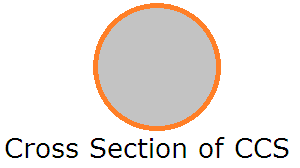Copper Clad Steel Wire (CCS)
CCS wire is a bi-metal that good mechanical properties of steel , specially tensile strength, combined with good electrical properties of copper. Plus, corrosion problem of steel wire is covered with copper. In some segments of cable production what is exactly needed. Steel wire still has high electric resistance which makes CCS wire not suitable for power transmission. Case of RF signal transmitting and also high frequency data signal transmission has different scenario. Skin Effect takes the lead and makes CCS wire as good as solid copper. High impedance values of steel wire and in contrast low impedance values of copper triggers the skin effect where high frequency signals use only the surface of the conductor.
 Applications:
CCS is used in Coaxial cables, telephone drop lines , and
power distribution channels as grounding/earth wire purpose. In coaxial cables
; CCS is used as inner conductor. Coaxial is more resistant to tensile with
CCS. Smaller in diameter and highly cost effective compare to solid copper
cable. If coaxial cable has to be installed from pole to pole aerial,
there is no more need for a stand by steel rope up to certain level.
CCS as inner conductor would permit higher tensile stress in compare to bare
copper wire.
Applications:
CCS is used in Coaxial cables, telephone drop lines , and
power distribution channels as grounding/earth wire purpose. In coaxial cables
; CCS is used as inner conductor. Coaxial is more resistant to tensile with
CCS. Smaller in diameter and highly cost effective compare to solid copper
cable. If coaxial cable has to be installed from pole to pole aerial,
there is no more need for a stand by steel rope up to certain level.
CCS as inner conductor would permit higher tensile stress in compare to bare
copper wire.
CCS used in telephone cable
for almost same purposes. CCS allows greater span length to telephone drop
lines and in many cases steel wire suspension rope is no more needed. At this
point CCS becomes cost effective in competition against both copper and CCA.
Quality Measures: Quality of CCS wire is determined by its conductivity compared to IACS (International Annealed Copper Standard) standard.
For Example :
1,00 mm CCS %21.
This
means conductivity of this wire is equivalent to 21% of same size copper wire.
CCS may be in various grades. These grades are always referenced by percentage
which also determines the quality of wire. Most common are 21%,
30%and 40%. There are ccs wire suppliers and producers who classify
thier product by the thickness of copper layer which is irrelevant in terms of
conductivity. On the other hand, IACS percentage value is final and precise.
